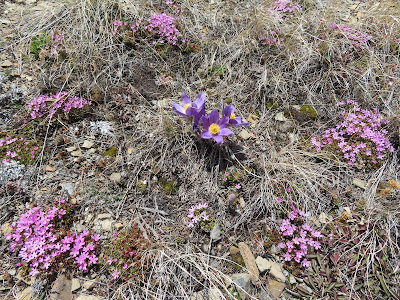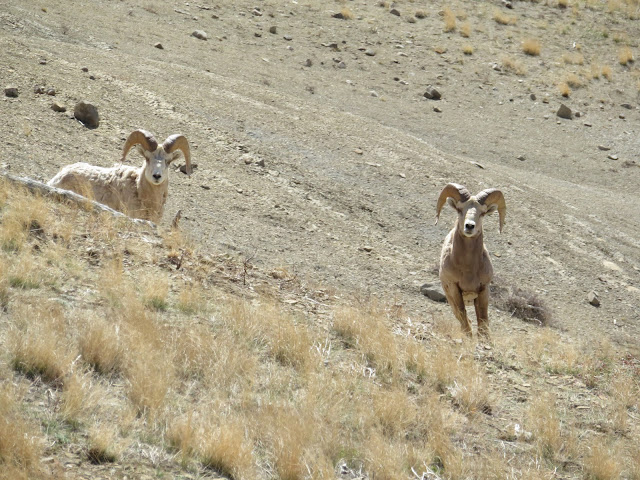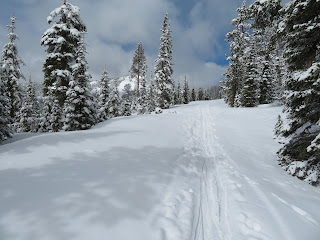 |
| The Elk meadows adjacent to Pioneer Ridge in Little Belts |
 |
| The Falls Creek Falls, with some snow above it |
 |
| Dearborn River Devil's Glen |
 |
| Lupine in the Muddy Creek valley, one of my favorite wildflowers |
 | ||
| Muddy Creek Falls |
 |
| In the Muddy Creek canyon, Gordon Whirry makes his frigid way across |
I returned to three old favorites this week --- the Dearborn Canyon's Devil's Glen, and an exploratory on the Pioneer Ridge in the Little Belt Mountains just east of the Belt Creek Ranger Station, and Muddy Creek Falls on the Rocky Mountain Front.
The weather has been almost summer-like --- clear skies, light breezes and warm temperatures. Hard to believe that we've cross country skied on this week in previous years.
I can't help myself wondering about the mindset that would provoke all the private property protectiveness (selfishness) in the Dearborn Canyon beneath magnificent Steamboat Mountain.
There are now hard-fought narrow easements into the Dearborn Canyon and the Falls Creek tributary.
The posted land signs and fences are numerous and obnoxious in this area, where landowners whose land abuts the public land. These landowners benefit copiously from their access to the public lands, but are stingy when it comes to public access to public lands.
Yes, they have granted a very narrow strip to Devil's Glen and now there's a more generous right of way to Falls Creek in the past year thanks to the Rocky Mountain Elk Foundation. Falls Creek had been closed to public access for many years previous to that.
This is the area where a landowner was murdered by a neighbor in a property dispute.
On hilltops high above Falls Creek are cabins, and along the now closed road to the Dearborn, are large cabins and lots of posted and no trespass signs that keep hikers to the thin strip that parallels that road.
I hiked both Devil's Glen and then to the Falls Creek Falls --- both easily done in a day hike. I wanted to see the spring runoff churn on the Dearborn and over the Falls Creek Falls, and was not disappointed. On the Devil's Glen portion I checked out the climber's informal trail up Steamboat and was surprised to see how improved it is. I suspect the students from the nearby Wilderness Bible Camp have been hammering it.
The following day I wandered back into the Little Belts and old-favorite Pioneer Ridge, reversing my route from a couple of weeks, going up the trail and back down through the grassy elk meadows. There was very little snow and no ticks. I did a little exploring, going beyond the 7,000 feet high point where I usually stop. I found a pair of binoculars that appear to have been left by a hunter last year in the meadows. There were gorgeous wildflowers throughout the hike, particularly bluebells. The trail crew had still not been through, so I had to wade my way through and around a considerable number of deadfalls.
The week's capstone hike had to be Muddy Creek Falls, an off-trail trek west of Bynum below Mount Werner.
This hike is spectacular all the way, on a route that follows the rocky stream-bed, which is dry for nearly a mile.
The falls are located in a deep Zion Park-like canyon, which still had some snow in it.
The canyon is narrow enough that it is impossible to navigate it to a view of the falls without getting your feet wet in the water, made even colder by the snowmelt.
What makes this area so special is that it has been reclaimed from extensive natural gas exploration and even production ---- there's still an old well pipe visible adjacent to the stream and old production roads now being reclaimed by nature.
The development has been halted and this area is a favorite of grizzlies.
Despite a gorgeous day we saw only one other (very odd) party of two backpackers going to the site, which may be the most spectacular on the Front.
It had been several years since I've done this trip and I was surprised to see the erosion that has created high banks on the creek. The old "trail" had disappeared to the erosion in many spots.
After enjoying a leisurely lunch at the base of the falls we left the canyon on the north side of the creek, ascending in the rock, climbing about 400 feet, looking for a ridge line before descending to the floor again where we got great views of the cliffs to the south and the greening of the hillside as the aspen has begun leafing out.
Then we turned back uphill and grabbed a lower ridge, which we walked out.
I was delighted by the flowering of the lupine, one of my favorite wildflowers. There were numerous arrowleaf blooms as well.





























